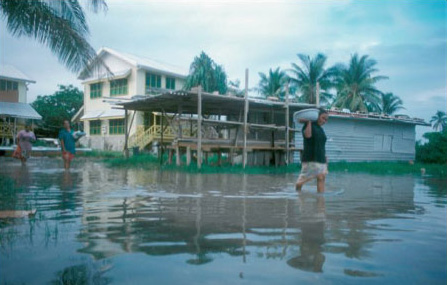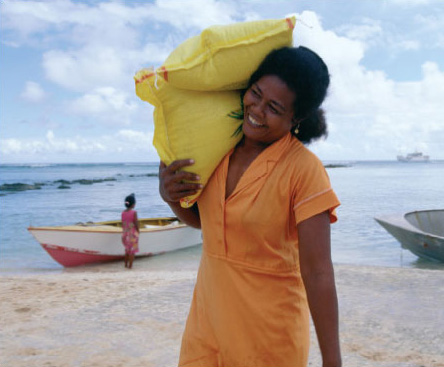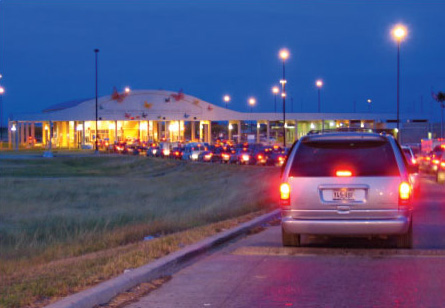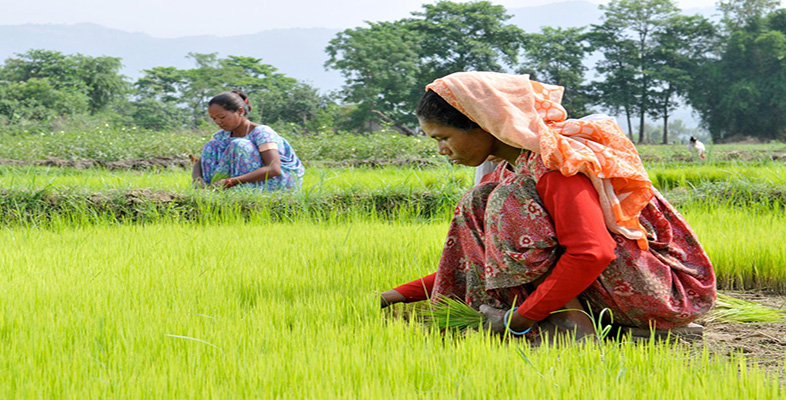2.3 Divisions that matter: thinking through territories
Without losing our focus on the planet as a whole, it is time now to return to what Paani Laupepa from Tuvalu refers to as the ‘front line’ of climate change: those islands that are particularly vulnerable to rising sea level and associated climatic hazards (Lynas, 2003). It has often been said that low-lying coral islands like Tuvalu or Kiribas in the Pacific Ocean, or the Maldives in the Indian Ocean, are acting as a kind of early warning system for global climate change. Sea level is expected to rise with even a modest increase in global temperatures, both because of the contribution of melting glacial ice to the world's oceans and because water expands when its temperature rises.
As Conisbee and Simms (2003) remind us, the Intergovernmental Panel on Climate Change (IPCC) predicts a sea level rise over this century of somewhere between 9 and 88 cm. These figures seem at once strangely precise and wildly divergent, and it is not surprising that they provoke uncertainty and fear in the inhabitants of low-lying islands. Moreover, islanders and coastal dwellers in tropical regions face the prospect not only of gradually rising seas, but of an increase in the incidence and intensity of cyclones along with the temporary surges in sea level that accompany these storms. In Tuvalu, as we can see in Figure 4, high tides can also produce flooding.

As we saw from Reading 1A, the island republic of Tuvalu has begun legal proceedings against some of the nation states it considers especially responsible for generating the hazards associated with anthropogenic climate change.
Activity 3
Now turn to Reading 1C (Reuters News Service, 2002a) entitled Tiny Tuvalu sues United States over rising sea level’ and Reading 1D (Reuters News Service, 2002b) entitled Tuvalu seeks help in US global warming lawsuit’. Both of the news items in the readings emerged from the second Earth Summit, a gathering of representatives of countries from around the world which convened in Johannesburg, South Africa in 2002 to pick up on discussions about environmental issues in a worldwide context.
What do these reports tell us about divisions or differences within the ‘globalised world’?
In the light of this information, and what you have already read about Tuvalu and its people, where do you think the loyalties or attachments of the Tuvaluans lie?
Click to view Reading 1C (2 pages, 0.05MB). [Tip: hold Ctrl and click a link to open it in a new tab. (Hide tip)]
Click to view Reading 1D (2 pages, 0.05MB).
The idea of ‘tiny Tuvalu’ (Reuters News Service, 2002a) – officially the world's second smallest nation – taking on much larger countries like the USA has a kind of ‘David and Goliath’ feel to it. If the threat to Tuvalu has a clear global framing, the way in which the problem is being couched and responded to also seems to rely upon, if not to reinforce, a sense of separate countries or nation states. Indeed, there is a kind of ‘us’ and ‘them’ division which appears to be taking shape around the distinction between those who are likely to suffer the most from global climate change and those who have contributed the most to the problem. Statistics about energy consumption and contribution to carbon emissions add substance to this division.
Taken together, the four readings we have looked at suggest that the people of Tuvalu – or at least their spokespeople – tell a story which brings together a sense of the interconnectedness of global processes with a clear focus on the predicament of their own nation and other small island nations who are similarly at risk. It is interesting to note that Tuvalu only joined the United Nations (UN) in 1999, and did so in large part to draw attention to the islands' vulnerability to climate change. The expense of being a UN member was easily covered by Tuvalu selling its internet domain address extension – which happened to be ‘.tv’ – the equivalent of the United Kingdom's ‘.uk’, or Russia's ‘.ru’. In 1998, a Californian company, Idealab, agreed to pay the government of Tuvalu US$4 million each year for the next 20 years in return for selling on the .tv address code to media companies who want to signal their role in television (such as 4kids.tv, hollywood.tv and bollywood.tv).
The Kyoto Protocol mentioned in Readings 1A, 1C and 1D was an agreement of the majority of the world's nations to limit their carbon emissions, with the onus on the most developed or heavily industrialised economies. Though it was non-binding, the Kyoto Protocol nevertheless articulated a basic consensus that use of fossil fuels and other carbon-emitting activities were in the process of affecting global climate change. Negotiations were extremely complex, but at its simplest the Kyoto Protocol was based around the premise that countries or nation states should not persist in activities that are known to damage or threaten other countries.
Although global climate change raises new issues, the principle of nation states not impinging in harmful ways on the territories of other nation states is an old and familiar one (Batty and Gray, 1996). At the same time, it is often tensions or disagreements between nation states that bring the nation states’ distinctiveness and defining characteristics into clearer focus. In the case of Tuvalu, which achieved independence from UK rule in 1978, the issue of climate change seems also to be giving the people an opportunity to speak of their attachment to their islands and to voice what it is they find important about the place in which they live. As Tuvalu Finance Minister Bikenibeu Paeniu said: ‘we are not encouraging people to leave because of climate change. It's our land. It's where we live’ (Reuters News Service, 2002b).
Consequently in a paradoxical kind of way, the very threat to the territory of Tuvalu also seems to be helping define this territory, for the people who live there, and in the eyes of the wider world. But what exactly is under threat? Or to put it another way: what do we mean by ‘territory’? In Section 1, I talked about changes on a globe or map and the possibility of seeing areas of land alter their shape or even disappear completely. This scenario conveys a sense of ‘territory’ that may well feel quite familiar: that is, territory as a particular area or parcel of land. Viewed in this way, we can think of the territory of Tuvalu as the nine coral atolls lying in the South Pacific, a combined land area of around 10 square miles (26 square kilometres), which is inhabited (in 2005) by some 11,600 people.
When we view territory as a specific area of land, the kind of outlines or borders that we can see depicted on a map take on a special importance, for they play a major role in defining the territory in question. By identifying a border on a map, we can usually tell quite quickly and easily what belongs within a particular territory (an area, country or region) and what doesn't. In other words, we can make a distinction between what is included and what is excluded: between an inside and an outside. But borders are not only important on maps. They also tend to play a big part in defining a territory at ‘ground level’, in the lived experience of those people who inhabit a particular piece of land. This border may be some recognisable physical feature, such as a river, mountain range or coastline. Or in other instances, especially in the case of a country or nation state, it might well be a human-made demarcation, such as a fence or wall.
A border, however, does more than simply divide a territory from the world around it. There is also an important sense in which it connects a territory with its surroundings, which is to say that it also functions as a zone of transition or a point of passage from one place to another (Figures 5 and 6. In this regard, passing through or crossing a border can be quite a momentous event, for it often marks a significant change in the conditions or circumstances under which people live. We can see this with particular clarity in the case of people who are desperate to cross from one country to another, those for whom a safe transit across a border can be a life-changing experience. But it is not only human beings whose lives may be transformed by passing through borders. As we will see in Section 3.2, crossing a border, such as the beach that separates land from ocean, can also mark an important transition for other, non-human, forms of life.


Borders, then, tend to play a practical and meaningful part in defining territories. But there are ways of defining territories other than through a consideration of boundaries or outlines. And there are ways of conceiving of, or experiencing, territory other than as a simple area of land. As accounts of the threat to Tuvalu seem to suggest, there is more at risk than changing outlines or diminished land area; something more is at stake than a certain area of land distributed among a certain number of people. Indeed, with the funds coming in from the sale of their internet domain address, the Tuvaluans could probably purchase some fairly substantial real estate elsewhere in the world.
What comes through in the voices of the people of Tuvalu is an attachment to their islands: the affirming of a whole way of life that is bound up with the place they live. And this points to a way of thinking about and experiencing territory not simply as a pocket of land, but more as a set of relationships. You might recall that in Reading 1A journalist Mark Lynas (2003) spoke of ‘a world that seemed to be unravelling’. ‘Unravelling’ suggests that a whole weave of ties or connections is being undone, evoking a sense of territory as a kind of pattern or fabric in which many different things are bound together.
In this sense, we might still conceive of territory as a particular parcel of land along with the borders around it, but we should keep in mind that there is a lot more going on as well: an interweaving of land with all its inhabitants and their ways of life. Viewed in this more complex sense, territory is not so easy for maps to depict. While a map, a globe or a satellite photograph of a region might give us the broad outlines of territories, it is difficult for such static images to reveal relationships between different elements and the patterns they form. But together with land areas and borders, it is this tangle of relationships that holds a territory such as the islands of Tuvalu together, giving it coherence and a character or identity of its own. In this regard, we might think of the various problems associated with changing climate as tugging at the weave of island territories, their increasing severity raising the chance that the whole might undo or come apart. In the extreme case, the scenario that former Prime Minister Toaripi Lauti talks of in Reading 1A, the people of Tuvalu may shift elsewhere. More than a simple move to another land, this could be viewed as entailing an unravelling and re-weaving of relationships.
In this section we have used the concept of territory as a way to help make sense of what it is that climate change threatens; what it is that people rally together to defend against such threats. The territory we have focused on is a group of atolls in the midst of the Pacific, which can be viewed at once as discrete pockets of land bordered by ocean, and as a weave of different elements. Each of the subsequent chapters in this book will look at other examples of territory, on a range of different scales – some much larger than these islands, others very much smaller. And in each case, we will see that what defines a particular territory is not just its size or shape and the borders which surround it, but also the relationships among the various things or ‘ingredients’ that make it up.
But once we start to think about territories as having borders, which are points of passage as well as barriers, and once we begin to consider the different elements of which territories are comprised, it soon becomes apparent that there is little sense in looking at territories in isolation. What are also important are the things which come and go – the movements and connections that link territories with the world around them. You will recall that we came to consider the notion of islands as territories under threat through the issue of the interplay between connectedness – on a global scale – and what it felt like to be at the ‘ground level’ of climate change in a particular place. Just as it is helpful to have a sense of how territories have their own distinct identities, which can really matter to all those who live there, it is important to understand how connections or flows play a part in the lives of territories. Section 2.4 explores this notion of ‘flow’, and what it means for our understanding of island life.
